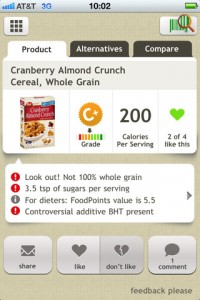
Fooducate
Are mobile health apps helping people become more aware about how healthy the food they at the grocery store is? A post over AdAge this week makes the case that this trend is on the up and up.
AdAge reports that there are about 60,000 items in the average grocery store, which supposedly makes it difficult for consumers to compare how healthy different foods are: "The new mobile tools are designed to bring a sense of transparency to store aisles, aiding in healthy purchase decisions. And they're surprisingly well penetrated: Of U.S. smartphone owners -- now about half the mobile-phone-toting population -- 44 percent have a health-related app, according to a January comScore survey."
That comScore survey has been in the news quite a bit lately. Last week a comScore rep told the New York Times that about 33 percent of people with smartphones in the US tracked their diet or their exercises with their mobile devices and about 35 percent used the devices to track their diet. Most of the health-related apps available for smartphone users are fitness and diet related, but most of the diet apps are intended for use to log meals and calories not shop for food. Another metric that has been well-received: 2011 Forrester survey found that 37 percent of mobile health app users had used an app to track their food intake at least once.
AdAge pointed to a few apps intended for use in the grocery store aisle: Fooducate, MyFoodWatch, AllergyEats and Don't Eat That.
Fooducate enables users to scan product barcodes with their smartphone's camera to look up a letter grade for that food item. The algorithm used to generate that letter grade was developed with the help of a team of dietitians, according to AdAge.
Fooducate has been downloaded "millions of times" since it launched for iPhone users in January 2011. Some 500,000 people use the app or its corresponding website each week. Since the smartphone user base in the US is now at about 100 million people, if all 500,000 regular Fooducate users were on smartphones, that makes for about half percent adoption. It's hard to believe that more than a few percent of total US smartphone users are using or have even tried any one of these food education apps. Goes without saying the 44 percent adoption figure for health apps from comScore includes a wide variety of health-related apps.
Perhaps the most interesting metric about Fooducate's user base: 75 percent is female and some 35 percent have a child at home, according to the AdAge report.














